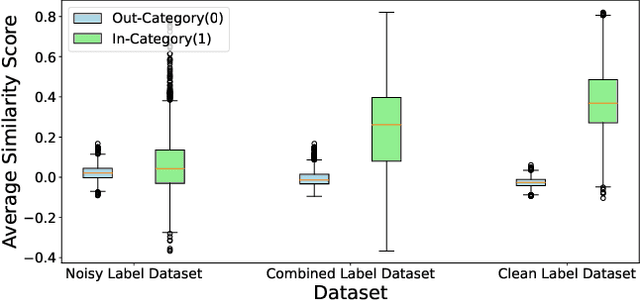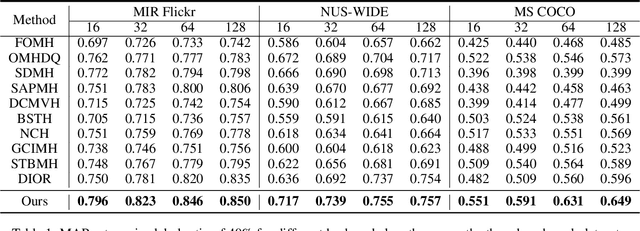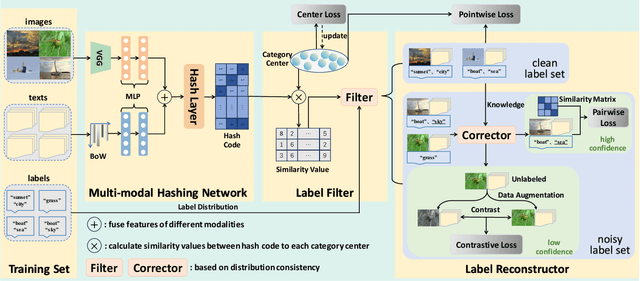Rong-Cheng Tu
AD-FM: Multimodal LLMs for Anomaly Detection via Multi-Stage Reasoning and Fine-Grained Reward Optimization
Aug 06, 2025Abstract:While Multimodal Large Language Models (MLLMs) demonstrate remarkable capabilities across diverse domains, their application to specialized anomaly detection (AD) remains constrained by domain adaptation challenges. Existing Group Relative Policy Optimization (GRPO) based approaches suffer from two critical limitations: inadequate training data utilization when models produce uniform responses, and insufficient supervision over reasoning processes that encourage immediate binary decisions without deliberative analysis. We propose a comprehensive framework addressing these limitations through two synergistic innovations. First, we introduce a multi-stage deliberative reasoning process that guides models from region identification to focused examination, generating diverse response patterns essential for GRPO optimization while enabling structured supervision over analytical workflows. Second, we develop a fine-grained reward mechanism incorporating classification accuracy and localization supervision, transforming binary feedback into continuous signals that distinguish genuine analytical insight from spurious correctness. Comprehensive evaluation across multiple industrial datasets demonstrates substantial performance improvements in adapting general vision-language models to specialized anomaly detection. Our method achieves superior accuracy with efficient adaptation of existing annotations, effectively bridging the gap between general-purpose MLLM capabilities and the fine-grained visual discrimination required for detecting subtle manufacturing defects and structural irregularities.
Intra-Trajectory Consistency for Reward Modeling
Jun 10, 2025Abstract:Reward models are critical for improving large language models (LLMs), particularly in reinforcement learning from human feedback (RLHF) or inference-time verification. Current reward modeling typically relies on scores of overall responses to learn the outcome rewards for the responses. However, since the response-level scores are coarse-grained supervision signals, the reward model struggles to identify the specific components within a response trajectory that truly correlate with the scores, leading to poor generalization on unseen responses. In this paper, we propose to leverage generation probabilities to establish reward consistency between processes in the response trajectory, which allows the response-level supervisory signal to propagate across processes, thereby providing additional fine-grained signals for reward learning. Building on analysis under the Bayesian framework, we develop an intra-trajectory consistency regularization to enforce that adjacent processes with higher next-token generation probability maintain more consistent rewards. We apply the proposed regularization to the advanced outcome reward model, improving its performance on RewardBench. Besides, we show that the reward model trained with the proposed regularization induces better DPO-aligned policies and achieves better best-of-N (BON) inference-time verification results. Our code is provided in https://github.com/chaoyang101/ICRM.
A Survey of Automatic Evaluation Methods on Text, Visual and Speech Generations
Jun 06, 2025Abstract:Recent advances in deep learning have significantly enhanced generative AI capabilities across text, images, and audio. However, automatically evaluating the quality of these generated outputs presents ongoing challenges. Although numerous automatic evaluation methods exist, current research lacks a systematic framework that comprehensively organizes these methods across text, visual, and audio modalities. To address this issue, we present a comprehensive review and a unified taxonomy of automatic evaluation methods for generated content across all three modalities; We identify five fundamental paradigms that characterize existing evaluation approaches across these domains. Our analysis begins by examining evaluation methods for text generation, where techniques are most mature. We then extend this framework to image and audio generation, demonstrating its broad applicability. Finally, we discuss promising directions for future research in cross-modal evaluation methodologies.
MLLM-Guided VLM Fine-Tuning with Joint Inference for Zero-Shot Composed Image Retrieval
May 26, 2025Abstract:Existing Zero-Shot Composed Image Retrieval (ZS-CIR) methods typically train adapters that convert reference images into pseudo-text tokens, which are concatenated with the modifying text and processed by frozen text encoders in pretrained VLMs or LLMs. While this design leverages the strengths of large pretrained models, it only supervises the adapter to produce encoder-compatible tokens that loosely preserve visual semantics. Crucially, it does not directly optimize the composed query representation to capture the full intent of the composition or to align with the target semantics, thereby limiting retrieval performance, particularly in cases involving fine-grained or complex visual transformations. To address this problem, we propose MLLM-Guided VLM Fine-Tuning with Joint Inference (MVFT-JI), a novel approach that leverages a pretrained multimodal large language model (MLLM) to construct two complementary training tasks using only unlabeled images: target text retrieval taskand text-to-image retrieval task. By jointly optimizing these tasks, our method enables the VLM to inherently acquire robust compositional retrieval capabilities, supported by the provided theoretical justifications and empirical validation. Furthermore, during inference, we further prompt the MLLM to generate target texts from composed queries and compute retrieval scores by integrating similarities between (i) the composed query and candidate images, and (ii) the MLLM-generated target text and candidate images. This strategy effectively combines the VLM's semantic alignment strengths with the MLLM's reasoning capabilities.
Multimodal Reasoning Agent for Zero-Shot Composed Image Retrieval
May 26, 2025Abstract:Zero-Shot Composed Image Retrieval (ZS-CIR) aims to retrieve target images given a compositional query, consisting of a reference image and a modifying text-without relying on annotated training data. Existing approaches often generate a synthetic target text using large language models (LLMs) to serve as an intermediate anchor between the compositional query and the target image. Models are then trained to align the compositional query with the generated text, and separately align images with their corresponding texts using contrastive learning. However, this reliance on intermediate text introduces error propagation, as inaccuracies in query-to-text and text-to-image mappings accumulate, ultimately degrading retrieval performance. To address these problems, we propose a novel framework by employing a Multimodal Reasoning Agent (MRA) for ZS-CIR. MRA eliminates the dependence on textual intermediaries by directly constructing triplets, <reference image, modification text, target image>, using only unlabeled image data. By training on these synthetic triplets, our model learns to capture the relationships between compositional queries and candidate images directly. Extensive experiments on three standard CIR benchmarks demonstrate the effectiveness of our approach. On the FashionIQ dataset, our method improves Average R@10 by at least 7.5\% over existing baselines; on CIRR, it boosts R@1 by 9.6\%; and on CIRCO, it increases mAP@5 by 9.5\%.
VORTA: Efficient Video Diffusion via Routing Sparse Attention
May 24, 2025Abstract:Video Diffusion Transformers (VDiTs) have achieved remarkable progress in high-quality video generation, but remain computationally expensive due to the quadratic complexity of attention over high-dimensional video sequences. Recent attention acceleration methods leverage the sparsity of attention patterns to improve efficiency; however, they often overlook inefficiencies of redundant long-range interactions. To address this problem, we propose \textbf{VORTA}, an acceleration framework with two novel components: 1) a sparse attention mechanism that efficiently captures long-range dependencies, and 2) a routing strategy that adaptively replaces full 3D attention with specialized sparse attention variants throughout the sampling process. It achieves a $1.76\times$ end-to-end speedup without quality loss on VBench. Furthermore, VORTA can seamlessly integrate with various other acceleration methods, such as caching and step distillation, reaching up to $14.41\times$ speedup with negligible performance degradation. VORTA demonstrates its efficiency and enhances the practicality of VDiTs in real-world settings.
T2I-Eval-R1: Reinforcement Learning-Driven Reasoning for Interpretable Text-to-Image Evaluation
May 23, 2025Abstract:The rapid progress in diffusion-based text-to-image (T2I) generation has created an urgent need for interpretable automatic evaluation methods that can assess the quality of generated images, therefore reducing the human annotation burden. To reduce the prohibitive cost of relying on commercial models for large-scale evaluation, and to improve the reasoning capabilities of open-source models, recent research has explored supervised fine-tuning (SFT) of multimodal large language models (MLLMs) as dedicated T2I evaluators. However, SFT approaches typically rely on high-quality critique datasets, which are either generated by proprietary LLMs-with potential issues of bias and inconsistency-or annotated by humans at high cost, limiting their scalability and generalization. To address these limitations, we propose T2I-Eval-R1, a novel reinforcement learning framework that trains open-source MLLMs using only coarse-grained quality scores, thereby avoiding the need for annotating high-quality interpretable evaluation rationale. Our approach integrates Group Relative Policy Optimization (GRPO) into the instruction-tuning process, enabling models to generate both scalar scores and interpretable reasoning chains with only easy accessible annotated judgment scores or preferences. Furthermore, we introduce a continuous reward formulation that encourages score diversity and provides stable optimization signals, leading to more robust and discriminative evaluation behavior. Experimental results on three established T2I meta-evaluation benchmarks demonstrate that T2I-Eval-R1 achieves significantly higher alignment with human assessments and offers more accurate interpretable score rationales compared to strong baseline methods.
Robust Distribution Alignment for Industrial Anomaly Detection under Distribution Shift
Mar 19, 2025Abstract:Anomaly detection plays a crucial role in quality control for industrial applications. However, ensuring robustness under unseen domain shifts such as lighting variations or sensor drift remains a significant challenge. Existing methods attempt to address domain shifts by training generalizable models but often rely on prior knowledge of target distributions and can hardly generalise to backbones designed for other data modalities. To overcome these limitations, we build upon memory-bank-based anomaly detection methods, optimizing a robust Sinkhorn distance on limited target training data to enhance generalization to unseen target domains. We evaluate the effectiveness on both 2D and 3D anomaly detection benchmarks with simulated distribution shifts. Our proposed method demonstrates superior results compared with state-of-the-art anomaly detection and domain adaptation methods.
AsymRnR: Video Diffusion Transformers Acceleration with Asymmetric Reduction and Restoration
Dec 16, 2024Abstract:Video Diffusion Transformers (DiTs) have demonstrated significant potential for generating high-fidelity videos but are computationally intensive. Existing acceleration methods include distillation, which requires costly retraining, and feature caching, which is highly sensitive to network architecture. Recent token reduction methods are training-free and architecture-agnostic, offering greater flexibility and wider applicability. However, they enforce the same sequence length across different components, constraining their acceleration potential. We observe that intra-sequence redundancy in video DiTs varies across features, blocks, and denoising timesteps. Building on this observation, we propose Asymmetric Reduction and Restoration (AsymRnR), a training-free approach to accelerate video DiTs. It offers a flexible and adaptive strategy that reduces the number of tokens based on their redundancy to enhance both acceleration and generation quality. We further propose matching cache to facilitate faster processing. Integrated into state-of-the-art video DiTs, AsymRnR achieves a superior speedup without compromising the quality.
Distribution-Consistency-Guided Multi-modal Hashing
Dec 15, 2024



Abstract:Multi-modal hashing methods have gained popularity due to their fast speed and low storage requirements. Among them, the supervised methods demonstrate better performance by utilizing labels as supervisory signals compared with unsupervised methods. Currently, for almost all supervised multi-modal hashing methods, there is a hidden assumption that training sets have no noisy labels. However, labels are often annotated incorrectly due to manual labeling in real-world scenarios, which will greatly harm the retrieval performance. To address this issue, we first discover a significant distribution consistency pattern through experiments, i.e., the 1-0 distribution of the presence or absence of each category in the label is consistent with the high-low distribution of similarity scores of the hash codes relative to category centers. Then, inspired by this pattern, we propose a novel Distribution-Consistency-Guided Multi-modal Hashing (DCGMH), which aims to filter and reconstruct noisy labels to enhance retrieval performance. Specifically, the proposed method first randomly initializes several category centers, which are used to compute the high-low distribution of similarity scores; Noisy and clean labels are then separately filtered out via the discovered distribution consistency pattern to mitigate the impact of noisy labels; Subsequently, a correction strategy, which is indirectly designed via the distribution consistency pattern, is applied to the filtered noisy labels, correcting high-confidence ones while treating low-confidence ones as unlabeled for unsupervised learning, thereby further enhancing the model's performance. Extensive experiments on three widely used datasets demonstrate the superiority of the proposed method compared to state-of-the-art baselines in multi-modal retrieval tasks. The code is available at https://github.com/LiuJinyu1229/DCGMH.
 Add to Chrome
Add to Chrome Add to Firefox
Add to Firefox Add to Edge
Add to Edge